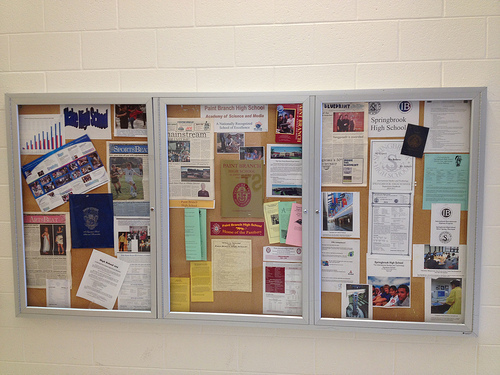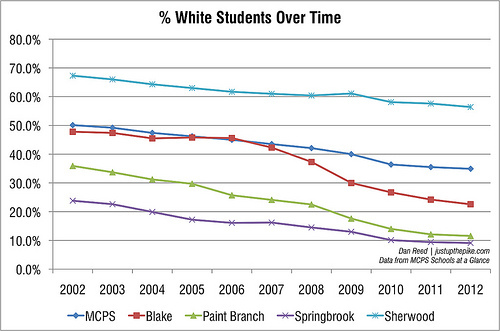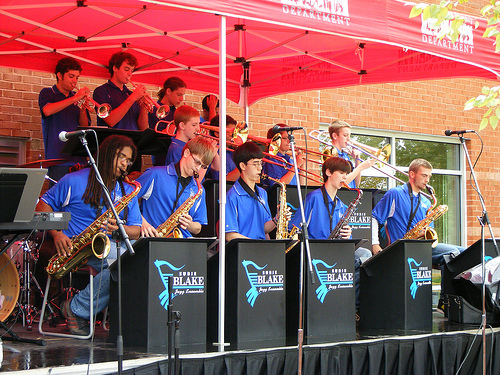Montgomery’s experiment with school choice really isn’t
Each fall, thousands of 8th graders in Montgomery County participate in Maryland’s oldest experiment in school choice, the Northeast and Downcounty consortia. Intended to prevent the school system’s growing segregation, the consortia’s 8 schools are not only more isolated than before, but academic performance has suffered.
Since the 1970’s, Montgomery County Public Schools (MCPS) has struggled to close the “achievement gap” between white and minority students and create more integrated schools. While officials had some success with magnet schools, in the 1990’s, they sought a new approach with James Hubert Blake High School, which was being built near Olney.
Instead of redrawing the catchment boundaries, a long and controversial process, the Board of Education decided to let students integrate themselves by letting them choose between the new school and 3 nearby schools, Sherwood, Paint Branch and Springbrook. In 1998, the US Department of Education gave MCPS a $2.9 million grant to set up the Northeast Consortium.
From “controlled choice” to “preferred choice”
Each school in the consortium had a unique “signature program”: Blake had fine arts and humanities, Paint Branch had science and media, and Springbrook had information technology. The schools would compete for students, making each program stronger and more distinct and hopefully discouraging them from leaving for private school. If the schools failed to integrate, a “controlled choice” program would take over, assigning students based on race and ethnicity.
But Sherwood never made it into the consortium, due to parent complaints about the uncertainty of a new school and long bus rides. There were unspoken concerns about mixing students from Sherwood, which was predominantly white and affluent, with Springbrook and Paint Branch, which were poorer and majority-minority.
“Sherwood parents [were] afraid of their kids going to Springbrook,” said Pat Ryan, a civic activist who helped plan the consortium, during a 2008 interview. “I talked to a lot of parents who said they moved to Olney because it’s a predominantly white area and they wanted their kids to go to school with white kids.”
While some neighborhoods in Olney were still redistricted into the consortium, MCPS created “base areas” for each school as a concession, guaranteeing that those residents could attend Blake. Officials called this “preferred choice.”
The problem repeated itself with the Downcounty Consortium, which MCPS started in 2004 with Montgomery Blair, Albert Einstein, John F. Kennedy, Wheaton, and Northwood high schools. While the Board of Education originally considered including adjacent Bethesda-Chevy Chase High School, parent outcry led them to drop it.
Schools unsuccessfully compete for middle-class students
Some Sherwood students resisted being redistricted, but school officials quickly noticed that Blake, the emerging top choice, was siphoning white and affluent students from Springbrook and Paint Branch.
To encourage a similar demographic mix at each school, in 2006 the Board of Education gave extra weight to the choices of students on free and reduced lunch (FARMS). A federal appeals court had declared the system’s prior use of race in school assignments unconstitutional.
Immediately, the number of students who received their first choice fell. In 2002, every single kid in the consortium got their first choice, but only 85% did in 2006. Not surprisingly, parents and students were livid.

The percentage of students now or ever on free or reduced lunch at the 3 consortium high schools, Sherwood and MCPS over time.
But instead of becoming more integrated, the Northeast Consortium schools lost white and higher-income students, even as Sherwood’s racial and socioeconomic mix remained steady. SAT scores plummeted in the consortium, but stayed the same at Sherwood.
To compete for a dwindling pool of middle-class students, each school began copying the others’ signature programs. Here’s what they offer today:
Blake: The arts, humanities and public service, science, technology, engineering
and mathematics, business and consumer services
Paint Branch: Science and media, finance, engineering technology, child development
and education, NJROTC, and restaurant management
Today, 97% of Northeast Consortium students get their first choice. With a new building that opened last fall, Paint Branch is now tied with Blake for first choice. But given very similar choices, students seem to end up at their base school, whether by choice or default. In 2008, 73% of students at Paint Branch came from that school’s base area, compared to 59% at Blake and 58% at Springbrook.
Were the consortia worth it?
In recent years, county officials have questioned the value of the Northeast and Downcounty consortia, which have neither improved academic performance nor provided socioeconomic and racial balance. That may have been less of an issue if Sherwood and B-CC had been involved, or if the “base areas” hadn’t been added.
I was in one of the first classes to participate in the Northeast Consortium, and I chose Blake, where I graduated in 2005. I had a great experience, and certainly a different one that had I been sent to my neighborhood school, Paint Branch. But it appears that less than 10 years later, East County students have very different choices.
In 2009, the County Council’s Office of Legislative Oversight asked if the consortia, which cost over $3 million to run each year, were a good use of public funds. When she ran for office, Councilmember Nancy Navarro, whose district includes both consortia, said she’s open to making them neighborhood schools again.
But school administrators say that regardless of the consortia schools’ demographics, they can be fixed. Next, we’ll talk to MCPS superintendent Dr. Joshua Starr about his thoughts on integration, school choice, and his plans to turn around Wheaton and Springbrook.




